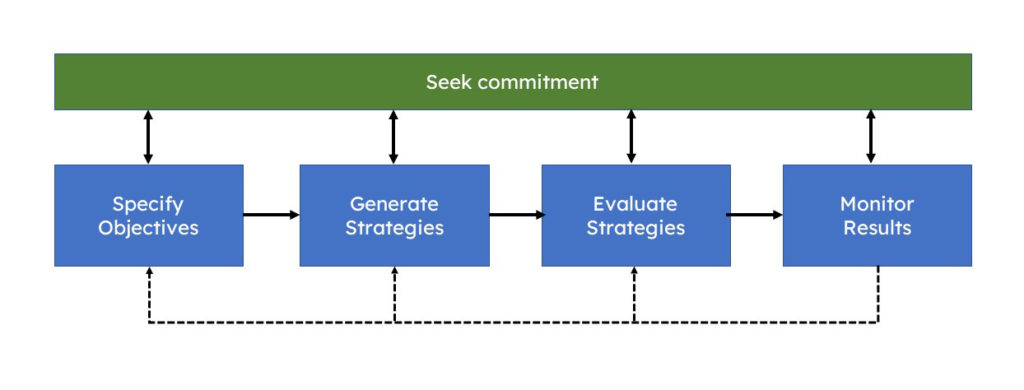A 5 step planning process helps formalize strategic planning. It can help in making the strategy more successful. Additionally, it also makes the process easy to follow. Research shows that formal planning may be more beneficial for larger endeavors. Let us see, how it can be used to develop organizational strategy.
Contents
When should we go for step-by-step planning
There are two major schools of thought in strategy: design school and emergent school. While design school advocates that there is a correct way of planning strategy based on needs and conditions. On the other hand, the emergent school of strategy believes that strategy emerges over time. Planning can be done at any time. However, certain contexts necessitate step-by-step planning. Methods like 5 step planning process become more valuable in these situations:
- Mergers and Acquisitions
- New Product Development
- Market crisis
- Expansions in unknown territories
- Uncertainty in the external environment
- High competition or Rival threats
What is the 5 step planning process?
A school of thought in strategy suggests that executives should develop a strategy based on extant internal and external conditions. A planning process helps an organization in developing the strategy. Strategy thinktanks also call this an explicit approach. 5 step planning is an example of a formal planning process.
Amstrong developed the 5 step planning process. He proposed this process to ensure a higher success rate for planning. We have the following major steps, in the 5 step planning process:
- Defining Objectives
- Generation of alternative strategies
- Evaluation of alternatives(and selection of a strategy)
- Obtaining commitment
- Monitoring the results

Figure adapted from Amstrong, 1982
Defining Objectives
The objectives are essentially the center-point of the formal planning process. This is the first step in the planning process. Managers can start with the specification of the objectives. These objectives define the goals. One of the best ways of setting goals is to ensure the goals that work. You may read 34 research-backed tips to set workable goals. In essence, the goals must be specific and measurable. Here are some key issues that need to be looked at when we are defining objectives for planning.
- Include the perspective and expectations of all the stakeholders
- Map the expectations of all the stakeholders through stakeholder mapping techniques
- Distribute the work and responsibility
- Get the mid-level managers on-board with the planning process by taking their inputs
- Ensure that the objectives are economically and technologically feasible
Generation of alternative strategies
We often overestimate our potential to come up with a good solution. One of the ways of avoiding this is through multiple solutions in the early phase. You can conduct a brainstorming session to develop multiple competing strategies. Among these strategies, the best one can be selected by evaluating the pros and cons.
The work of project managers is paramount in this stage. Also, the best plans are those that are flexible and less resource-dependent. Additionally, when doing this step of the planning process, one should ensure that there are fewer or no bottlenecks.
Evaluation of alternatives(and selection of a strategy)
Traditional methods of evaluating the different strategies rely on consensus. Alternatively, apprehensions can be voiced for a strategy. Often, strategic success is more about reducing uncertainity and risks than creating a perfect plan.
If you need a more robust method, you can use the Delphi method. This method is more powerful at the evaluation of the alternatives. It relies on the responses of experts. You can also hire independent consultants to evaluate and rank the strategies.
Obtaining commitment
Top managers do most of the planning. However, execution is generally done by the lower and mid-level employees. One point of failure for any 5 step planning process could be in this step. Senior managers should develop this.
Commitment can come through a mutual understanding. We must take the subordinates on board with the idea. They must be made aware of their responsibilities. The deliverables must not come from a target. It should come from a shared goal.
Monitoring the results
Execution is more important than the plan. Here are some aspects that Amstrong has mentioned. We should try to monitor these.
- External environment (such as business landscape and competitors)
- Internal environment ( such as resources, capabilities)
- Actions of the organization and actions of competitors
- Linking actions to the outcomes (feedback based monitoring)
Insights from latest research on planning process
We have discussed some key aspects and processes of 5 step planning process. Modern research also suggests that we take a holistic and human approach. Our planning process has to be more meaningful for the employees. One of the largest endeavors by NASA was the lunar missions. A janitor is often quoted as “I’m Not Mopping the Floors, I’m Putting a Man on the Moon.” Can’t we try to emulate this in our plans?
Organizations have also been augmenting traditional tools with new ones. For instance, methods like cognitive mapping show good results. Also, a strategy can be developed around stories and narratives rather than upon bullet points.
